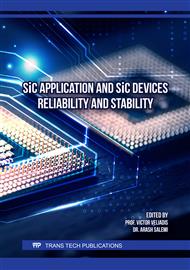[1]
Nasa, "NASA's lunar exploration program overview," 2020.
Google Scholar
[2]
European Space Agency (ESA), "ESA lunar exploration journey." Accessed: May 14, 2024. [Online]. Available: https://lunarexploration.esa.int/intro
Google Scholar
[3]
European Space Agency (ESA-ESTEC) Requirements & Standards Division, "ECSS-Q-ST-30-11C-Rev.2," 2021.
Google Scholar
[4]
J. W. Kolar and G. I. Ortiz, "Solid state transformer concepts in traction and smart grid applications." [Online]. Available: www.pes.ee.ethz.ch
Google Scholar
[5]
X. She, A. Q. Huang, and R. Burgos, "Review of solid-state transformer technologies and their application in power distribution systems," IEEE J Emerg Sel Top Power Electron, vol. 1, no. 3, p.186–198, Sep. 2013.
DOI: 10.1109/JESTPE.2013.2277917
Google Scholar
[6]
A. Rujas, V. M. Lopez, I. Villar, T. Nieva, and I. Larzabal, "SiC-hybrid based railway inverter for metro application with 3.3kV low inductance power modules," in IEEE Energy Conversion Congress & Expo (ECCE), 2019.
DOI: 10.1109/ecce.2019.8912684
Google Scholar
[7]
J. Zhu, H. Kim, H. Chen, R. Erickson, and D. Maksimovic, "High efficiency SiC traction inverter for electric vehicle applications," in IEEE Applied Power Electronics Conference and Exposition (APEC), IEEE, 2018.
DOI: 10.1109/apec.2018.8341204
Google Scholar
[8]
A. Matallana et al., "Power module electronics in HEV/EV applications: New trends in wide-bandgap semiconductor technologies and design aspects," Renewable and Sustainable Energy Reviews, vol. 113, p.109264, Oct. 2019.
DOI: 10.1016/J.RSER.2019.109264
Google Scholar
[9]
W. Perdikakis, M. J. Scott, K. J. Yost, C. Kitzmiller, B. Hall, and K. A. Sheets, "Comparison of Si and SiC EMI and efficiency in a two-level aerospace motor drive application," IEEE Transactions on Transportation Electrification, vol. 6, no. 4, p.1401–1411, Dec. 2020.
DOI: 10.1109/TTE.2020.3010499
Google Scholar
[10]
U. Nasir et al., "A SiC based 2-Level power converter for shape-and-space-restricted aerospace applications," in IEEE 13th International Conference on Power Electronics and Drive Systems (PEDS)., 2019.
DOI: 10.1109/peds44367.2019.8998907
Google Scholar
[11]
K. E. Bozak, L. R. Piñero, R. J. Scheidegger, M. V Aulisio, M. C. Gonzalez, and A. G. Birchenough, "High input voltage, silicon carbide power processing unit performance demonstration," in AIAA Propulsion & Energy Conference, 2015. [Online]. Available: https://ntrs.nasa.gov/search.jsp?R=20150023096
DOI: 10.2514/6.2015-3900
Google Scholar
[12]
R. J. Scheidegger, W. Santiago, K. E. Bozak, L. R. Piñero, and A. G. Birchenough, "High power silicon carbide (SiC) power processing unit development," 2015. [Online]. Available: https://ntrs.nasa.gov/search.jsp?R=20150023084
DOI: 10.1149/06911.0013ecst
Google Scholar
[13]
A. Lopez, P. F. Miaja, M. Arias, and A. Fernandez, "Circuit Proposal of a Latching Current Limiter for Space Applications Based on a SiC N-MOSFET," IEEE J Emerg Sel Top Power Electron, vol. 10, no. 5, p.5474–5485, Oct. 2022.
DOI: 10.1109/JESTPE.2022.3163585
Google Scholar
[14]
D. Marroquí et al., "Towards higher current and voltage LCLs," in 13th European Space Power Conference (ESPC) , 2023.
DOI: 10.1109/espc59009.2023.10298130
Google Scholar
[15]
A. F. Witulski et al., "Single-event burnout mechanisms in SiC power MOSFETs," IEEE Trans Nucl Sci, vol. 65, no. 8, p.1951–1955, Aug. 2018.
DOI: 10.1109/TNS.2018.2849405
Google Scholar
[16]
R. A. Johnson et al., "Unifying concepts for ion-induced leakage current degradation in silicon carbide Schottky power diodes," IEEE Trans Nucl Sci, vol. 67, no. 1, p.135–139, Jan. 2020.
DOI: 10.1109/TNS.2019.2947866
Google Scholar
[17]
A. Witulski et al., "Single-event effects in silicon carbide high voltage power devices for lunar exploration," 2023.
Google Scholar
[18]
A. Witulski et al., "Single-Event Effects in Silicon Carbide High Voltage Power Devices for Lunar Exploration," in Annual NASA Electronic Parts and Packaging (NEPP), 2023.
Google Scholar
[19]
C. Martinella et al., "Heavy-ion induced single event effects and latent damages in SiC power MOSFETs," Microelectronics Reliability, vol. 128, Jan. 2022.
DOI: 10.1016/j.microrel.2021.114423
Google Scholar
[20]
A. Sengupta et al., "Development of SEB-immune high voltage SiC power devices for lunar applications," in Annual NASA Electronic Parts and Packaging (NEPP), 2022.
Google Scholar
[21]
L. M. Tolbert, "Increasing switching performance of 10 kV SiC MOSFETs for medium voltage applications," in Swiss Chapter of IEEE PELS Webinar, 2022.
Google Scholar
[22]
V. Pala et al., "10 kV and 15 kV silicon carbide power MOSFETs for next-generation energy conversion and transmission systems," in IEEE Energy Conversion Congress and Exposition (ECCE) , 2014.
DOI: 10.1109/ecce.2014.6953428
Google Scholar


